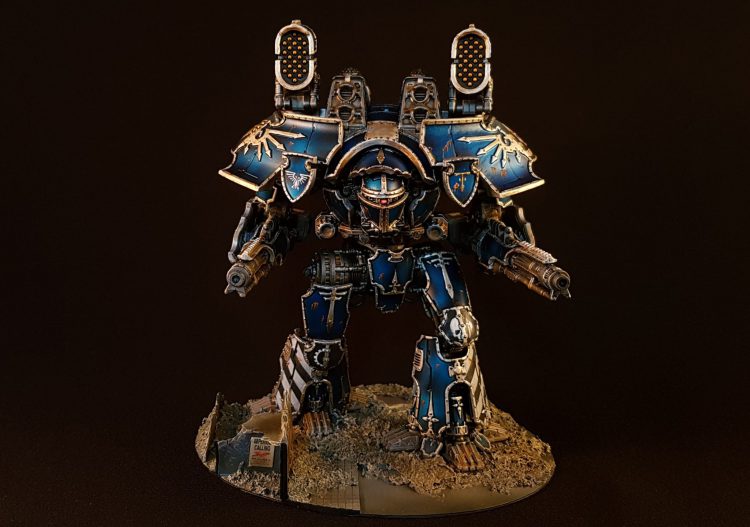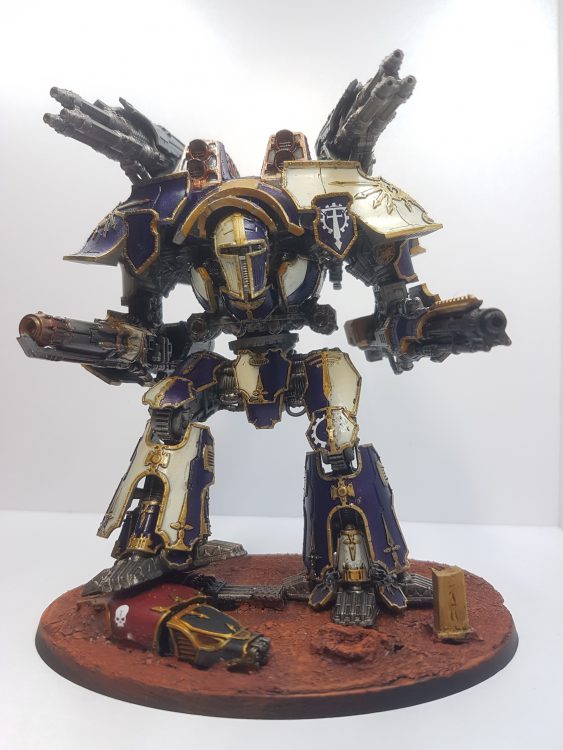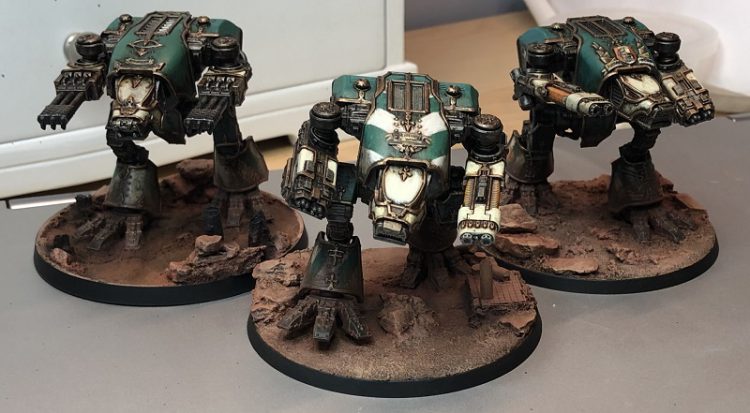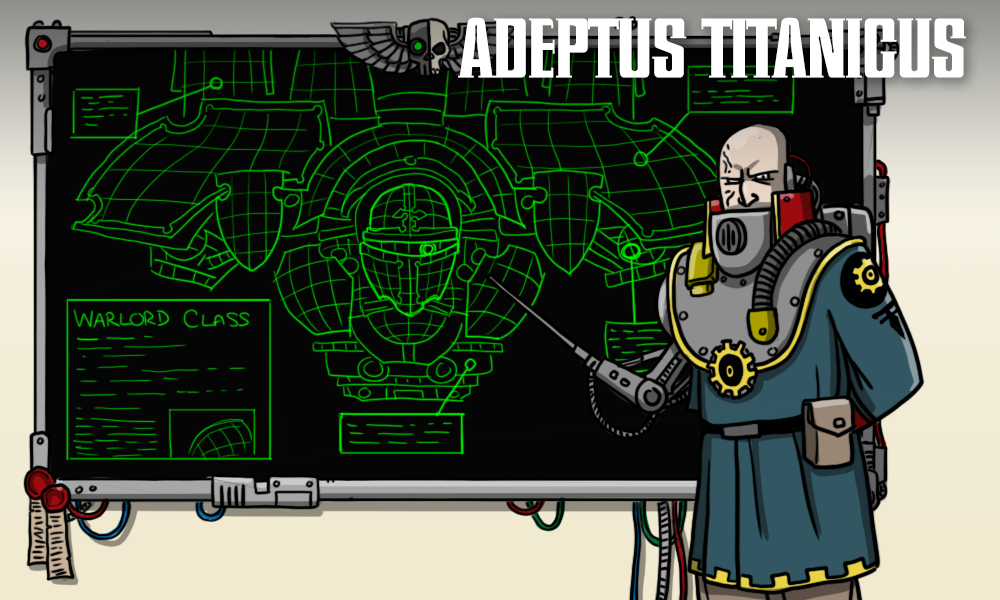Welcome back to Goonhammer’s series for aspiring Titan Principes. We here at Goonhammer’s own Collegia Titanica know that Adeptus Titanicus can seem intimidating to players unfamiliar with its particular quirks, but this series aims to equip you with everything you’ll need to play out epic clashes on the battlefields of the far future with your very own Titan Battlegroup. In this series, we’ll be walking you through how to build your battlegroup and command it to glory, including everything from which Titans to include and how to equip them, through to how to command them on the field of battle to secure ultimate victory.
[Editors’ Note: This article was originally published in October 2019. It has been updated to reflect new Legios and rules changes that have occurred since then, and is up to date as of September 2021.]
Following up on last week, we’re taking a look at the traitor Titan Legions available to choose from in the various rules sources. As before, these rules will form one half of the core identity of your battlegroup, giving you access to passive legion traits, additional stratagems and wargear you can purchase, and a set of Princeps traits to choose from in lieu of the ones on offer in the core rules. There’s an incredible amount of variety here, with plenty of room for you to take a particular legion and make it your own. Some of these are all-in on one particular aspect of the game, while others provide benefits that are more spread out.
After you choose your legion, you’ll need to choose a maniple as well. Some legions lend themselves to particular maniple traits or Titan selections, and you’ll want to do what you can to take advantage of those synergies. Make no mistake: planning to win a game of AT starts here, at the beginning of list construction. Start thinking of how you want to approach the game as you choose your Legion, and let that plan guide the decisions you make once you’ve declared your allegiance.

Legio Tempestus – “Stormlords”
OK, so if we’re being technical here, Tempestus split as a legion early in the heresy, with a significant portion of the legion remaining loyal and fighting against Horus. However, their entry in the Titans of Legend sets (more on these in a later article) comes in the Traitor box, and putting them here also just gives us a nice 50/50 split between this and our Loyalist Focus, so here we are. Regardless of whether you choose Tempestus’s crusading traitor faction or their more stay-at-home loyalist cousins, though, they bring a solid selection of rules that won’t disappoint.
The big attraction here is their Legio Trait, Glory In Death, which gives Stormlords Titans a chance to get one last shot off when they suffer catastrophic damage. Plus, the better the Titan is at passing Command checks, the more likely it is to get to fire all of its weapons, not just one of them. This isn’t something to rely on, but it does make situations where you lose a Titan before it activates slightly less painful. Add in Fury of the Machine for an additional chance to get one of the “attack” results on the Awakened Machine spirit, and Legio Tempestus is going to pick up a few more opportunities to shoot over the course of your average game when compared to other legions. They’re also decent at getting across the board – while Combat Drop is a bit expensive at 3SP for the risk that comes with it, the Storm-born personal trait is amazing, both opening up longer charges in the late game and helping you manage your reactor in the early game when it’s easier to set up the direction you’ll run in.
Taken together, Legio Tempestus is a fairly straightforward faction that offers some slight upside to take the edge off of riskier play. Knowing when that upside makes those risks worthwhile will take a few games to get the hang of, but the results you’re likely to see along the way will be spectacular.

Legio Mortis – “Death’s Heads”
Despite showing up on the back of most of the boxes for the game and having several full-page illustrations in the Core Rules, we didn’t actually get rules for Legio Mortis until the release of Titandeath. They have an interesting range of traits and optional choices that they can bring to bear throughout the course of the game. The Death’s Heads don’t necessarily lend themselves to any particular loadout, but can build in nearly any direction without having to worry about whether their rules will be helpful.
The biggest draw here is the March of the Dead stratagem, which costs you 3SP and forces you to give up the Opus in the first round, but lets each of your Titans make a free non-boosted move in the first strategy phase. You’re essentially buying a free Full Stride order for your entire maniple, giving you an extra couple of inches up the board without having to take heat or worry about failing a command check. Once you’ve brought your weapons to bear, Reaper’s Tally lets each of your Titans re-roll a single 1 during each shooting attack for every enemy Titan it’s killed. They can also ignore the effects of critical damage to the head for a round, letting you get in a key order when you need it or avoid taking penalties to hit with a wounded engine. Add in some decent wargear options and you’ve got a flexible Legion that can pose a threat with whatever you want to put on the table.
The Death’s Heads have some solid offensive punch that stays fairly consistent over the course of the game, between their ability to ignore mounting critical damage effects and use wargear and stratagems to assist with heat management. Nothing here is particularly incredible on its own, but the various options come together to create a solid force that only threatens to get more dangerous as the game goes on.
Legio Krytos – “God Breakers”
The God Breakers have some gorgeous heraldry and an amazing color scheme. Unfortunately, their rules are a little odd and hard to get mileage out of. Their legion-specific wargear is OK, if a bit lackluster, and their legio trait is all but obsoleted by the introduction of the Extergimus maniple.

Earthbreaker Missiles are interesting, but ultimately kind of a letdown – losing 80% of your shots to gain the Quake trait isn’t the best tradeoff. It does mean your Apocalypse missile launchers can still be somewhat relevant against void-less targets that haven’t suffered a ton of structure damage yet, but we’re not sure that’s worth 20 points.
We’ll be honest – if you’re looking at Krytos, it’s for the sweet paint scheme, and possibly for their Titan of Legend, the Hammer of Tyrants. If you bring that Warlord, you can just fire its sunfury on maximal with no hesitation since it ignores the downside of the Maximal Fire trait. Unfortunately, as of time of writing, you’re probably better off running your Krytos Titans without a ruleset to deny your opponent 2SP. Our fingers are crossed that, if a Traitor supplement similar to the Loyalist Legios book releases, it’ll bring Legio Krytos the glow-up they deserve.
Legio Fureans – “Tiger Eyes”
The Tiger Eyes are a fast-paced, aggressive legion who push their Titans’ reactors to the absolute limit, and then push a little harder – the flame-centric motifs in their heraldry aren’t just for show. Fureans battlegroups want to move fast and set up devastating alpha strikes, but are racing against the clock to take out their opponents before their own god-engines finally give in and their reactors melt down.
A Legio that can realistically play to any playstyle you want, whether it’s ranged combat or close-quarters melee, with upgrades making their weapons more reliable on the way in and a very tasty stratagem that allows some or all of your titans to fire one of their weapons twice in a combat phase. The real reason you’re playing these, though, is the striking paint scheme and the more frequent awakened machine spirit – especially since you’ll be able to choose which of the options you get. Push aggressively on defense and you’ll be able to sneak in a few extra shots – or even a smash attack if you’re lucky.
Legio Vulpa – “Death Stalkers”
The Death Stalkers are a proud legion who value victory in combat where they’re close enough to look their opponent in the eyes over all else. They specialize in bringing their weaponry to bear in the chaos of melee combat with a lethal precision that other legions struggle to match. If you want to march right up to your opponent and unload when they’re too close to miss, Legio Vulpa might be for you.
Your goal here is to get in close and fight your enemies in close combat. You’ll want to equip as many of your Titans as possible with Disruption Emitters for +2 to the strength of your melee and smash attacks, making any Titan you field into a legitimate melee threat. That includes Titans without melee weapons – your Honour and Blood Legio Trait improves your Titans’ WS by 1 when within 3″ of any enemy Titan, letting even Titans that don’t have a melee weapon hold their own in close quarters.
The Death Stalkers do one thing, but they do it very well. Just be careful that you don’t misjudge the distance to your target – there’s a “dead zone” from 2-3″ where the prospect of tearing into a target they can’t quite reach drives these Titans’ Princeps to a blind rage, imposing a penalty to hit. If you do hit that charge, though, it’s going to hurt.
Legio Vulcanum – “Dark Fire” and “Lords of Ruin”
Legio Vulcanum are actually two legios, not just one – the Dark Fire and the Lords of Ruin both hail from the same forge world, and typically work together, competing to see which of them can be the most effective in a given engagement. This is further complicated by both legions’ extensive use of cloning in building crews for their Titans. Vulcanum lets you bring two Princeps Seniores and allows you to pair off the Titans in your battlegroup to compete with one another for glory even as they coordinate their fire to obliterate your enemies.
These are strange legios though on the tabletop as well as in the lore who can take a very unique upgrade on any two titans – or any number of pairs of two Titans – to form a squadron for the game. Normally, Warhounds are the only Titans that can form into a squadron, but this lets you pair together Warlords, Reavers, and Warbringers in any combination. This drastically decreases the number of activations, but being able to share shields with a pair of Warlords allows them to withstand a substantial amount of punishment before taking hits to armour, as well as allowing you to activate them back to back in the combat phase, all but guaranteeing a kill before your target has a chance to fire back. The problem you’ll face is movement, since with enemies easily outmanoeuvring you you’ll need to think ahead more than normal and assume that some lighter Titans or knights will be hitting your flank.
Legio Interfector – “Murder Lords”
Interfector is another aggressive legion, but this time a bit less restrained. Their legion trait gives your Titans the option to trade their activation in the movement phase for one of three powerful effects applied at random, and they have two separate options that allow them to interfere with the opponent’s ability to issue orders to their own Titans. And if you really want to, you can turn your Princeps into a frothing lunatic and charge him right into the middle of the enemy battlegroup with a 60% chance of going critical when he’s finally destroyed. Meanwhile, Static Rounds is an incredibly upgrade to your megabolters and will absolutely shred void shields, giving you earlier and more consistent openings to start tearing your opponents apart.
I don’t think anyone was expecting subtlety from a legion calling themselves the “Murder Lords,” least of all the crews of these Titans. That being said, if you can handle letting go and having Horus take the wheel, Interfector can be a powerful, if unpredictable, force on the tabletop.
Legio Mordaxis – “Deathdealers”
These titans are slow, and I mean slow. But reliable. The Deathdealers literally seep with toxins designed to spread into any enemies that stray too close. The toxins the titans are filled with have corrupted and all but killed the crews of these machines.
In game terms, they miss out on a core mechanic since they can’t push their reactors for movement or for turns at any point, and as a result can have trouble closing to short range, making melee weapons a poor fit. However, they also cannot be slowed by Quake weapons or have their facing changed by Concussive effects. The Dark Mechanicum that has overseen these engines fills their weapons with toxins, giving them a much larger radius of damage at the cost of becoming slightly weaker. In game terms this allows any weapon that uses the 3″ blast template to upgrade it to a 5″ blast at the cost of -1 strength, a small price to pay on already powerful guns such as melta cannons for the improved reliability in hitting your target – as well as any other titans and knights that have strayed a little too close.

Legio Audax – “Ember Wolves”
Scouting Titans. All the time. Only. Unlike any other Legio, Audax only count smaller scouting Titans amongst their ranks, primarily (and in game terms only) Warhounds that are famously outfitted with Ursus Claws. If your thing is having more Titans on the table than your opponent and winning based on ganging up on larger engines, then you’re right at home here.
With a boost in strength to Ursus claws and their own unique maniple to put their Warhounds in, it’s easy to see why this would be a very fun Legio to play, if very limiting. Add in their unique wargear and some seriously scary tricks, and you’ve got a unique legion that gets a ton of mileage out of smaller Titans.
Legio Magna – “Flaming Skulls”
Not to be confused with the other flame-based Traitor Legio, Magna were one of the first Legios to proclaim allegiance to Horus after fighting alongside both the Word Bearer and Sons of Horus during the Great Crusade. It’s not too much of a surprise then that they march into battle accompanied by the wails of screaming fire spirits from their home world, making commands of nearby enemies more difficult.
With 2 different stratagems to choose from, you might easily spend all of your stratagem points on both of them, making your Titans that much more deadly when wielding melee and close ranged weaponry, as well as an upgrade to extend the Fusion effect of weapons to make them hit harder sooner as you close the gap. And once you get there, the penalty you’ll impose to your opponent’s Command checks will make their efforts to fight back that much less reliable.
Legio Infernus “Fire Masters”
Originally known as Legio Suturvora, their affinity for flame and melta weapons prompted them to opt for a somewhat less subtle name. If you want to burn opposing Titans to ash together with significant chunks of the surrounding scenery, look no further.
Inferno gun Warhounds are much more powerful in Infernus than in other legions due to their legion trait and unique wargear. If you’re playing into a list with a lot of models where you can consistently hit more than one target, they’ll be very dangerous. Consider a Venator maniple with a World Burner princeps in a Reaver with a melta cannon – use your Warhounds to pound down shields, then fire the melta cannon repeatedly to do massive damage.
Infernus also have reliable access to re-rolls, but have to take a penalty to Command checks to take advantage of them. It’s risky, but depending on your list it could be worth it. Take advantage of their traits, wargear, and their unique stratagem to hit your opponent hard when they least expect it.
Legio Vulturum “Gore Crows”
Shrouded in mystery, not much was known of the Gore Crows aside from their callous nature and exotic weaponry.
The Gore Crows are aptly named and are real Relentless Killers by gaining +1 to hit with all of their own engines for the remainder of a round in which an enemy has suffered Catastrophic Damage. But the real reason you’re taking these guys are for their extra explosive mega bolters, a little expensive maybe but gives the weapon Maximal Fire at the cost of a -1 to hit modifier at long range. This removes a bit of the mega bolters shield-stripping power at range, however being able to boost the strength up so much on top of things like structurally comprised locations and coordinated strikes can make more an extremely deadly weapon.
Legio Laniaskara “Impalers”
Offering another take on the “aggressive melee legion” role, Legio Laniaskara trades away better WS and weapon strength for guaranteed charges and a free smash attack after their melee weapons hit home. Add in some defensive wargear and the ability to let one of their Titans a free speed boost every round, and your opponents are going to have a rough time keeping you away from them.
The result here is a legion that isn’t quite as good with the Arioch Titan Power Claw, but can cause ridiculous amounts of damage on the charge with Reavers. Use a chainfist to open a hole in your target’s armor, then throw in a few more dice to go for the kill. Just be careful: you really need to get a charge off for this legion to work, and if your opponent still has 3SP left when the turn to do that comes around, they’re probably going to pop Vox Blackout, which will really put a damper on your party. That being said, if you want a fast, aggressive melee force, Laniaskara are worth a look.
Legio Kulisaetai “Gatekeepers”
True to their name, the Gatekeepers offer some useful tricks for a gunline legion together with a pre-game move that will let them get into position and lock down the areas of the board they need to hold. Add to this the ability to ignore penalties to Command checks, and they can reliably put out a solid amount of firepower when it counts. Toss in their Accelerated Autoloaders wargear for double-firing Apocalypse missile launchers once per game, and you can line up some devastating attacks at a key moment.
Methodical Advance is the real star of the show here, offering an effect that would be 3 stratagem points anywhere else but for its restriction: it only applies to Titans of a single scale. To get the most use out of this, you’ll want to lean towards maniples like the Extergimus, Corsair, or Perpetua to load up on several of the same Titan. Once you’re there, though, you can use their unique stratagem to extend the short range of one of your Titan’s weapons by 6″, potentially increasing your accuracy and even letting your melta use its Fusion trait against targets 18″ away.
Legio Damicium “Unbroken Lords”
Few Titan legions are as good at fighting through otherwise crippling damage as the Unbroken Lords – between their Secondary Plating, which lets them downgrade the first Critical Hit they suffer to a Devastating, and their ability to ignore a single Critical Damage effect during the Movement and Command phases, letting them stay in the fight when other Legios would be all but dead.
Of course, that’s not all they’ve got going for them. Their order reliability for their smaller Titans is pretty good, since as long as they can see an enemy Titan that’s the same size or larger, they get a bonus to Command checks. And if your opponent gets too close to your Princeps, don’t worry – the Beyond Death Princeps trait will let you move your Titan D6″ in the direction of your choice and automatically suffer a magazine detonation on its death, punishing your opponent for their hubris.
Legio Tritonis “Dark Tide”
While they are technically traitors, the Dark Tide are somewhat unique here in that they’re more accurately described as a Blackshield legion – their loyalty wasn’t to the Emperor or the Warmaster, but to their Forge World, Arachnus. Regardless, they’ve got some pretty nasty tricks, like being able to sub in a Warlord in exchange for any mandatory Reavers in their maniple. Try putting one in a Ferrox and watch the carnage.
Their most powerful trick, though, is their stratagem, Stygian Veil. This lets them drop three tokens on the board that exert a 6″ radius Command check debuff and block all line of sight that would be drawn within a 3″ radius. This is an incredibly powerful stratagem that lets them carve up the battlefield and dictate the flow of the fight. And if that weren’t enough, they’ve got a Princeps trait that lets them do it twice.
For the Warmaster
The Traitor Legios bring some powerful effects to the table, and sport some of the coolest paint schemes in the game to boot. Regardless of what your preferred strategy is, if you don’t feel up to pledging your allegiance to the Emperor, there’s something here for you.


